If you’re searching for a stunning, one-of-a-kind material to transform your home, let us introduce you to Alaska granite. This striking stone – quarried primarily in India’s Rajasthan and in Brazil – is quickly becoming a favourite among homeowners and designers alike. What makes Alaska granite so special? Unlike typical granite, which often has similar patterns across different slabs, each piece of Alaska granite is completely unique, offering a beautiful mix of colours and textures that can’t be found anywhere else.
In today’s design world, where individuality is key, Alaska granite stands out as a fantastic option for anyone looking to add a personal touch to their space. Whether you’re revamping your kitchen, designing a luxurious bathroom, or creating a standout feature wall, Alaska granite can elevate your design with its distinctive charm. In this guide, we’ll explore the various types of Alaska granite and discover why this gorgeous stone is capturing the hearts of architects, interior designers, and homeowners alike. (And despite its name, Alaska granite isn’t from Alaska – it’s named for its appearance and is actually sourced from India and Brazil.) You just might find the perfect centerpiece for your next project!
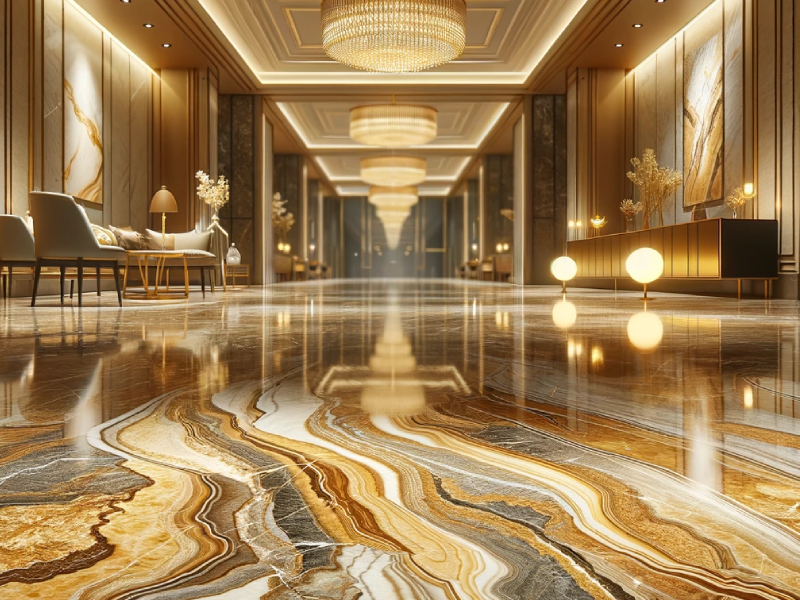
What is Alaska Granite?
Alaska Granite is a type of natural stone that looks bold, dramatic, and different from typical granite. It’s known for its beautiful patterns and big crystal-like spots that you don’t normally see in regular granite.
But here’s the interesting part: technically, it’s a special type of granite called pegmatite.
What’s Pegmatite? (In Simple Terms)
Imagine lava (magma) deep inside the Earth. Over time, this magma cools down and becomes solid rock — that’s how granite is formed.
Now, in the last stage of this cooling process, when only a little bit of magma is left, something special happens:
- This leftover magma has more water and gases.
- It’s more fluid, so minerals can move around easily.
Because of this, the minerals grow into much larger crystals — instead of small specks, you get big chunks of quartz, feldspar, and mica.
This type of rock, with large, dramatic crystals, is called pegmatite.
So Why Is It Called Alaska Granite?
Even though it’s pegmatite, it looks and behaves very similar to granite, so the stone industry calls it granite.
The name “Alaska” is just a trade name — it doesn’t come from Alaska. Most Alaska granite is quarried in India (especially Rajasthan) and in Brazil.
The name is inspired by its icy white appearance in some varieties, like Alaska White Granite. In short, Alaska Granite = a bolder, more decorative form of granite used for countertops, flooring, feature walls, and luxury interiors—where making a statement matters.
Sometimes, you might hear resined granite slabs referred to as Alaska granite too, which is another way these beautiful stones are prepared for use. We will discuss further why it is called so.
Why It’s So Popular:
- Every slab is unique — no two pieces look the same.
- The patterns are more artistic and flowing than normal granite.
- It’s strong, durable, and can be polished for a high-end look.
- Perfect for kitchen countertops, flooring, feature walls, etc.
Also READ | Understanding the Process of Slab Resining of Natural Stones – Marble, Quartzite & Granite

How Is Alaska Granite Different from Typical Granite?
Alaska granite, being a pegmatite rock, differs from typical granite in its formation, composition, and appearance. While both are igneous rocks, they have distinct characteristics:
Formation
- Pegmatites develop during the final stages of magma crystallization, which is the process that occurs when molten rock cools and solidifies.
- Typical granite, on the other hand, is a more common igneous rock that forms from the slow cooling and solidification of magma beneath the Earth’s surface. This cooling process takes place over thousands of years, resulting in smaller crystals and a more uniform appearance.
In short, typical granite cools slowly and evenly, whereas Alaska granite cools with a burst of fluid-assisted growth at the end – leading to those giant, eye-catching crystal structures.
Composition
Both typical granite and Alaska granite share similar minerals (quartz, feldspar, mica, etc.), but the crystal sizes and distribution differ.
- In Alaska Granite, as the magma cools, it’s often mixed with water and other gases, creating conditions that allow for the growth of much larger crystals.
- Typical granite has a more uniform crystal size, with minerals like quartz, feldspar, and mica distributed throughout.
Appearance
- Because of those formation and compositional differences, Alaska granite slabs look dramatically different from standard granite. Each Alaska granite slab is one-of-a-kind, showcasing bold patterns, swirls, and veins of various colors. You might find a mix of white, cream, gold, black, gray, or even blue tones in one slab, arranged in striking, painterly patterns.
- In a typical granite (say, a common black or brown granite), the overall pattern is more uniform and repetitive (salt-and-pepper or consistent flecks).
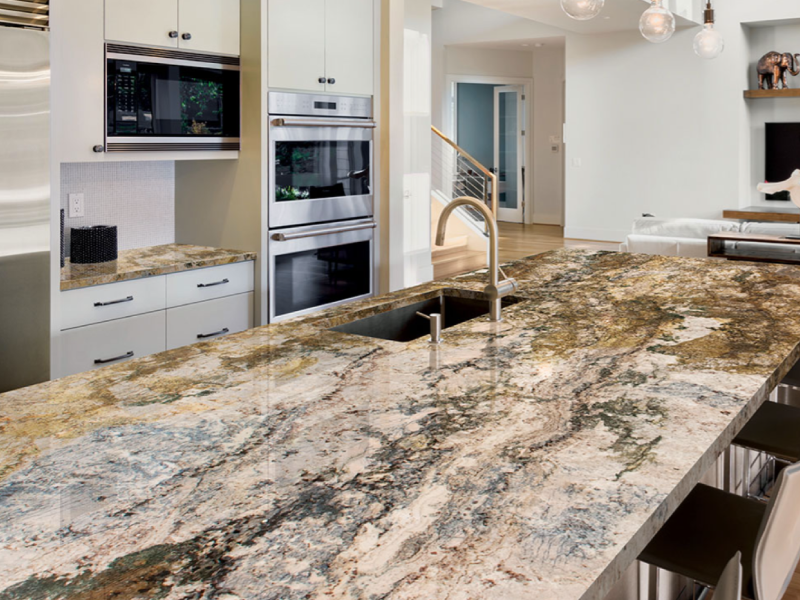
How is Alaska Granite Manufactured or Processed?
The manufacturing process for Alaska granite is quite similar to that of regular granite, with one important difference: Alaska granite goes through an extra step called slab resining. Let’s break down the process so you can see how it all comes together.
Quarrying: The first step involves extracting large blocks of granite from quarries, which are basically big holes in the ground where the stone is found. This is where the granite begins its journey from earth to your home.
Transportation: Once the granite blocks are cut from the quarry, they are transported to factories where they will be processed further.
Block Cutting: At the factory, these large granite blocks are cut into slabs, which are more manageable for use in countertops, flooring, and other applications.
Slab Polishing: After cutting, the slabs are polished to bring out their natural beauty. This final step gives the granite its smooth and shiny finish.
Slab Resining: Here’s where Alaska granite stands out. The resining process involves applying a special resin to the surface of the granite slabs. This resin fills in any natural voids, cracks, or imperfections in the stone. The goal is to improve the structural integrity of the granite, making it stronger and more durable. Plus, it helps achieve a more uniform and polished look.
It’s important to note that when done correctly, slab resining doesn’t compromise the durability of the granite. In fact, it enhances it! This means you can enjoy the beauty of Alaska granite while also ensuring that it stands up to the wear and tear of everyday life.
Popular Types of Alaska Granite
Alaska granite is often used synonymously with Alaska White granite, but it’s not limited to just one type. In reality, “Alaska granite” refers to a broad range of granite varieties that include not only white but also red, blue, pink, gold, beige, and more—each with distinct patterns and mineral compositions.
Alaska White Granite
Alaska White Granite is a beautiful stone that has a pure white colour with delicate veins running through it. It has a timeless and elegant appearance that adds a touch of refinement to any space. This type goes well with different design styles, so it’s popular for homes and businesses
Also READ | Alaska White Granite: Everything You Need to Know
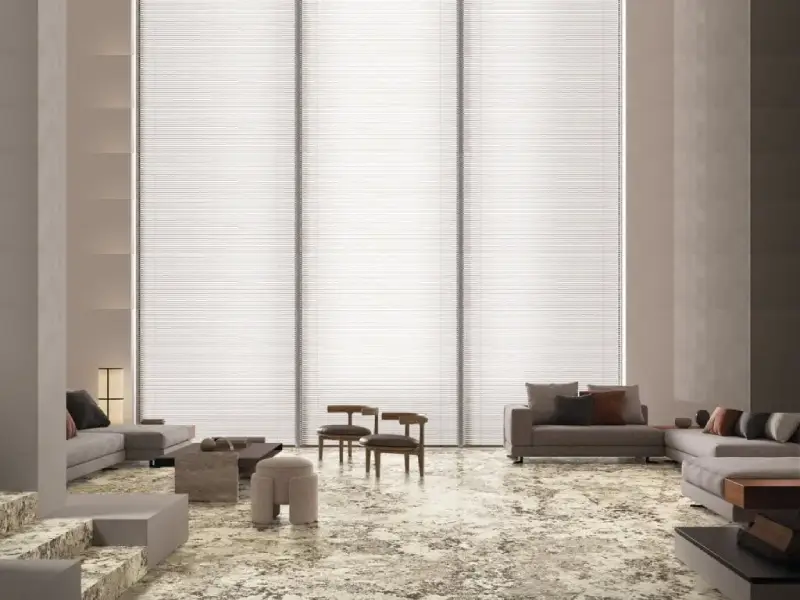
Alaska Red Granite
Alaska Red Granite is a type of stone that has a strong and noticeable appearance. It has a deep red colour with veins that stand out. This thing looks really nice and makes places feel cosy and lively. It also lasts a long time and stays beautiful.
Also Read | Red Granite: Everything you need to know.
Alaska Gold Granite
The Alaska Gold Granite exudes elegance and luxury, with its foundation resembling sun-kissed gold. With its detailed veins, it brings a fancy touch to indoor spaces, making it a popular choice for people who want to create a luxurious atmosphere.
Also Read: Alaska Gold Granite Flooring: Luxury Options
Alaska Pink Granite
Alaska Pink Granite has a soft pink colour with subtle veins, making it a beautiful and charming option. It’s perfect for creating soothing situations because of its soft colours, which give off a calming aura.
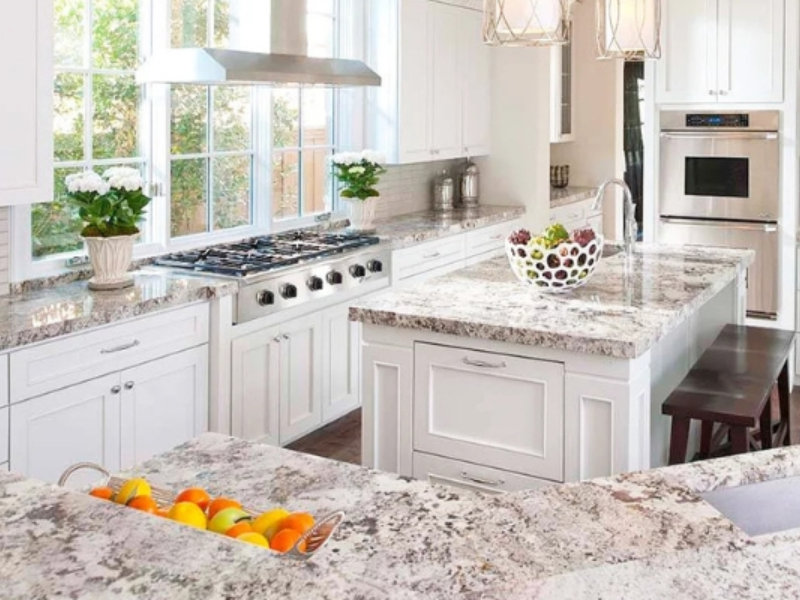
Alaska Blue Granite
Alaska Blue granite is a unique type of stone that has a creamy background colour. It also has veins of black, blue, and grey minerals running through it. The special features in this natural and unique granite will be different in each slab.
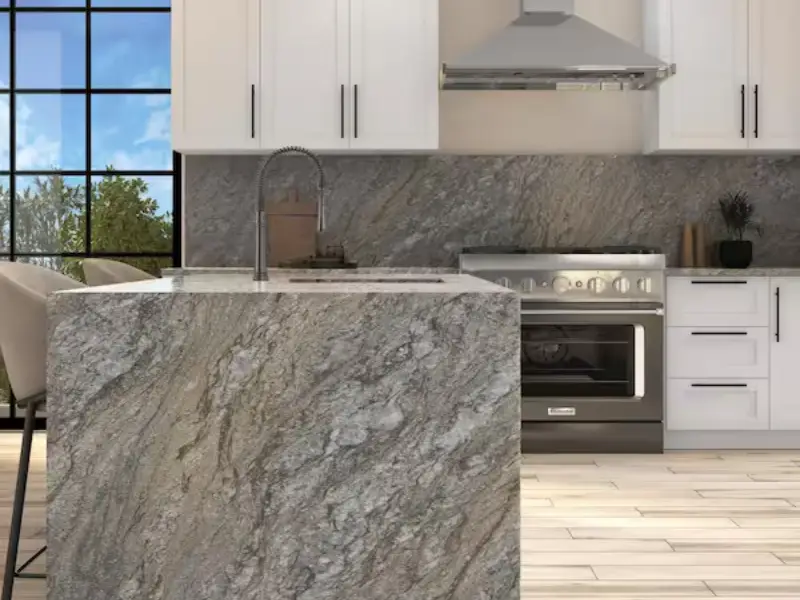
Comparing Uses: Typical Granite vs. Alaska Granite
Both typical granite and Alaska granite are strong, durable materials suitable for a variety of applications (countertops, flooring, wall cladding, etc.).
Typical granite is often chosen for its reliability, availability, and classic look. It comes in a wide range of colours and patterns (from consistent blacks and greens to mottled reds and grays), making it a versatile choice that can fit many styles. Homeowners love regular granite for kitchen counters, bathroom vanities, and floors because it’s hard, heat-resistant, and scratch-resistant.
Alaska granite shares those durable qualities (after all, it’s still granite at its core), but it’s usually chosen for its standout appearance. Designers and homeowners who want a show-stopping feature– like an island countertop that draws all eyes, or a feature wall with dramatic veining – may prefer Alaska granite. Its bold, vibrant pattern can serve as a piece of art in the room.
In practical terms, you might use a typical granite when you want a cohesive, subtle look, and choose Alaska granite when you want a unique statement piece that defines the space. Neither is “better” in terms of performance – it’s more about aesthetic preference and budget (as we’ll discuss, Alaska granite tends to be pricier and slightly less abundant).
Countertops:
- This Granite is a popular choice for kitchen and bathroom countertops. Its durability and resistance to wear make it well-suited for high-traffic areas.
Flooring:
- The strong and durable nature of this granite makes it an excellent option for flooring in both residential and commercial spaces. It adds a touch of sophistication to any environment.
Wall Cladding:
- This Granite can be used for wall cladding to enhance the visual appeal of interior and exterior spaces. Its natural patterns and veins create a distinctive and elegant look.
Backsplashes:
- The beauty of this granite can be showcased in kitchen and bathroom backsplashes, adding a touch of luxury and uniqueness to these spaces.
Fireplace Surrounds:
- The heat-resistant properties of granite make it a suitable material for fireplace surrounds. This Granite can elevate the aesthetic of living spaces with its captivating patterns.
Decorative Elements:
- Alaska Granite can be crafted into decorative elements such as tabletops, bar-tops, or accent pieces, adding a touch of natural elegance to interior spaces.
Commercial Spaces:
- Due to its durability and low maintenance requirements, these Granite is a favored choice for various commercial spaces, including hotels, restaurants, and office buildings.
In summary, the applications of Alaska Granite extend across a wide range of design possibilities, bringing strength, beauty, and a touch of nature’s elegance to diverse spaces.
Pros and Cons of Alaska Granite
Like any material, Alaska granite comes with its set of advantages and a few considerations to keep in mind. Here’s a quick overview of the pros and cons:
Pros:
- Unique, Striking Appearance: The foremost selling point of Alaska granite is its unmatched beauty. Each slab is a one-of-a-kind masterpiece of nature, with bold patterns and colors. If you want a countertop or floor that no one else has, Alaska granite gives you that exclusivity. It serves as a functional surface and a piece of art, instantly elevating the aesthetics of any space.
- Durability and Strength: Alaska granite is still granite – which means it’s extremely hard and durable. It’s well-suited for high-traffic and heavy-use areas. You can cut on it, place hot pots on it, spill things (if sealed, spills won’t stain easily) – it handles it all. Many Alaska granites are feldspar-rich, which contributes to their hardness. In fact, Alaska Red and others are noted for high durability and heat resistance. With proper care, an Alaska granite countertop or floor can last for decades (even generations) without losing its charm.
- Adds Value and Luxury: Because Alaska granite is a premium material, installing it can increase the perceived value of your home. It’s often associated with high-end, luxury designs. If you’re looking to impress guests or future buyers, a beautiful Alaska granite feature can be a strong selling point. It signals that quality materials have been used in the space. Moreover, despite the higher upfront cost, its longevity means it’s a long-term investment – you likely won’t need to replace it for the life of the house.
- Low Maintenance: Granite in general is relatively low maintenance, and Alaska granite is no exception. Routine cleaning with mild soap and water is all it takes for day-to-day care. It’s scratch-resistant and heat-resistant. As long as you keep it sealed (typically once a year is recommended as a precaution), it’s also quite stain-resistant. There’s no need for fancy cleaners or constant fussing. In busy households (even those with kids or lots of cooking), Alaska granite holds up well with minimal special care.
Cons:
- Higher Cost: As discussed, Alaska granite comes at a premium price. It might not be the best choice if you’re on a tight budget. For large projects, the cost can add up quickly. Additionally, because each slab is unique, if you have to purchase multiple slabs, you might have to buy a bit extra to match patterns or waste from cutting – leading to higher expense. While many find it worth the cost (“expensive but worthwhile” as one source puts it), it’s certainly a consideration for budget-conscious projects.
- Variation and Matching: The very quality that makes Alaska granite appealing – its variability – can pose a challenge in some cases. If you have a large countertop that needs two slabs seamed together, or a big floor area that will use multiple batches of tiles, it can be tricky to find pieces that match or flow together since patterns can differ so much. For a seamless look, you often have to hand-select slabs cut from the same block or quarry face, which might not always be possible with limited supply. In contrast, with uniform granite or engineered stone, matching is easier. So, working with Alaska granite may require more careful planning and selection to ensure the end result looks cohesive.
- Availability: Not every stone yard or supplier will stock all the varieties of Alaska granite due to their exotic nature. You might have to hunt a bit to find the exact color you want, or wait for it to be imported. This can introduce delays in your project. Also, if you ever need a replacement piece later (say, you extend your counter or need an extra matching tile), it might be difficult to get a perfect match unless the supplier still has the same batch in stock. Essentially, Alaska granite isn’t as ubiquitously available as standard granite, so there’s a bit of dependency on quarry production and import cycles.
- Heavy and Hard to Install: This isn’t unique to Alaska granite but to all granites – it’s a very heavy material. Proper installation requires skilled professionals. The large slabs, especially when they have resin, are very solid (which is good for durability, but means they’re unforgiving if not handled correctly). If you’re in a very remote area, the transportation and installation logistics can be complex due to weight. Of course, once it’s in place, this isn’t an issue, but it’s worth noting as a consideration during the planning phase.
Overall, the pros of Alaska granite often outweigh the cons for those who desire its signature look. The cons mostly revolve around cost and practicality of sourcing, whereas the pros highlight its beauty and performance. If budget and sourcing align with your project, Alaska granite can be an incredibly rewarding choice that you’ll enjoy for years, with the “cons” being relatively manageable through good planning (like selecting slabs carefully and hiring experienced installers).
Alaska Granite Price
Alaska granite is generally priced higher than regular granite due to:
- Unique, non-repeating patterns
- Additional Resin processing for structure
- High demand due to its popularity
To give a rough idea: in India, standard granites might start at, say, ₹50-80 per square foot for common varieties, whereas Alaska granite can range around ₹100-200 per sq ft or more (approximately $12-$25 per square meter). Prices for Alaska granite vary depending on type, finish, size, thickness and availability.
| Type | Approx. Price (India, ₹/sq. ft.) | Notes |
|---|---|---|
| Alaska White Granite | ₹110 – ₹160 | Premium demand; good supply |
| Alaska Gold Granite | ₹130 – ₹190 | Slightly higher due to popularity |
| Alaska Red Granite | ₹110 – ₹150 | Higher durability; decorative use |
| Alaska Pink Granite | ₹100 – ₹140 | Decorative; lower supply |
| Alaska Blue Granite | ₹150 – ₹220 | Rare and niche |
Prices are ex-works and may increase with transport, customization, or international freight.
Of course, prices can vary widely. Within the Alaska granite family, some colors might be more abundant (thus cheaper) than others. Market conditions, quarry output, and even fashion trends (if a certain color is “in” this year) can affect price. It’s always a good idea to check with local stone suppliers for current pricing on specific Alaska granite colors.
ALSO READ | Granite Price Per Square Foot – Understanding Factors
Conclusion
Alaska granite isn't just another type of stone—it’s the result of a rare geological process that creates bold, unpredictable patterns and oversized crystals you won’t find in standard granite. Formed as a pegmatite, each slab reflects the final stage of magma cooling, where minerals take their time to grow and settle.
This is what sets it apart—not just visually, but in story and structure. It’s processed with care, often resined for strength and finish, and selected when a space demands something beyond the usual. For buyers, it means making a conscious decision: to choose character over uniformity, and origin over imitation.
If you're working on a project where the material matters, Alaska granite invites you to look beyond the surface. Not every slab will match, but none of them will go unnoticed.










